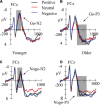The Automatic Emotion Regulation of Children Aged 8-12: An ERP Study
- PMID: 35801095
- PMCID: PMC9255229
- DOI: 10.3389/fnbeh.2022.921802
The Automatic Emotion Regulation of Children Aged 8-12: An ERP Study
Abstract
Emotion regulation in childhood and adolescence is related to their social development. Better emotion regulation is associated with great individual academic performance and mental health. However, compared with the research on emotion regulation strategies, children's automatic emotion regulation has been less investigated. Using event-related potential (ERP) technology, this study adopts the cued-emotion Go/Nogo paradigm to investigate the processing characteristics of automatic emotion regulation in children aged 8-12 years. The current study selected 34 younger group [16 boys, 18 girls, mean (M) ± SD = 8.91 ± 0.75], and 31 older group [18 boys, 13 girls, M ± SD = 11.26 ± 0.45]. The results showed that, for Nogo trials, the amplitude of N2 and P3 evoked by emotional faces were significantly larger than those evoked by neutral faces, reflecting the cognitive conflict experienced and the process of children's automatic response inhibition to emotional stimuli, respectively. However, no significant difference in N2 and P3 amplitude were found in Go trials, which may indicate that children aged 8-12 showed similar top-down control and similar motivated attention in this experiment, respectively. Further analysis found that the negative affect of temperament was significantly positively correlated with Nogo-P3 induced by neutral pictures (r = 0.37, p < 0.001), and preadolescents' social anxiety was significantly positively correlated with Nogo-P3 followed by neutral pictures (r = 0.31, p < 0.01). These findings can provide inspiration and empirical support for the promotion and intervention of emotion regulation in children and adolescents.
Keywords: Nogo-P3; automatic emotion regulation; children; social anxiety; temperament.
Copyright © 2022 Liu, Gao, Gao and Liu.
Conflict of interest statement
The authors declare that the research was conducted in the absence of any commercial or financial relationships that could be construed as a potential conflict of interest.
Figures





Similar articles
-
Time course of automatic emotion regulation during a facial Go/Nogo task.Biol Psychol. 2012 Feb;89(2):444-9. doi: 10.1016/j.biopsycho.2011.12.011. Epub 2011 Dec 23. Biol Psychol. 2012. PMID: 22200654
-
The development of automatic emotion regulation in an implicit emotional Go/NoGo paradigm and the association with depressive symptoms and anhedonia during adolescence.Neuroimage Clin. 2016 Jan 21;11:116-123. doi: 10.1016/j.nicl.2016.01.018. eCollection 2016. Neuroimage Clin. 2016. PMID: 26937379 Free PMC article.
-
Enhanced Nogo-P3 amplitudes of mothers compared with non-mother women during an emotional Go/Nogo task.J Physiol Anthropol. 2018 Apr 2;37(1):8. doi: 10.1186/s40101-018-0167-9. J Physiol Anthropol. 2018. PMID: 29609641 Free PMC article.
-
Event-Related Potentials in a Cued Go-NoGo Task Associated with Executive Functions in Adolescents with Autism Spectrum Disorder; A Case-Control Study.Front Neurosci. 2017 Jul 11;11:393. doi: 10.3389/fnins.2017.00393. eCollection 2017. Front Neurosci. 2017. PMID: 28744191 Free PMC article.
-
Influence of impulsiveness on emotional modulation of response inhibition: An ERP study.Clin Neurophysiol. 2015 Oct;126(10):1915-25. doi: 10.1016/j.clinph.2014.12.012. Epub 2014 Dec 23. Clin Neurophysiol. 2015. PMID: 25595704
Cited by
-
Research hot topics and frontiers in social anxiety over the past decade: a CiteSpace bibliometric analysis based on Web of Science database from 2013 to 2023.Front Psychiatry. 2024 Oct 23;15:1421907. doi: 10.3389/fpsyt.2024.1421907. eCollection 2024. Front Psychiatry. 2024. PMID: 39507284 Free PMC article. Review.
-
Development of a scale for the impact of emotion management on young athletes' training efficiency.Heliyon. 2024 Apr 23;10(9):e30069. doi: 10.1016/j.heliyon.2024.e30069. eCollection 2024 May 15. Heliyon. 2024. PMID: 38699037 Free PMC article.
-
Neural Correlates of Emotion Regulation and Associations With Disordered Eating During Preadolescence.Dev Psychobiol. 2025 Jan;67(1):e70009. doi: 10.1002/dev.70009. Dev Psychobiol. 2025. PMID: 39648280 Free PMC article.
References
LinkOut - more resources
Full Text Sources

